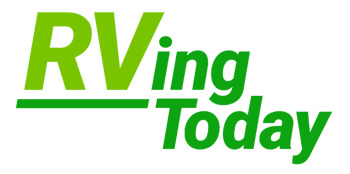RV Destinations
Tips from the Browns on Boondocking with a 40' Fifth Wheel.
Michelle Fontaine: With the influx of new RVers, and campgrounds feeling a little crowded, and a desire to find some kind of cost-effective camping, people are turning to boondocking, or dry camping.
Today, we’re visiting with our friends, Michelle and Jody Brown, in Sedona, Arizona, on BLM land. I asked Michelle’s mom, Gloria, what her camping experience was like 50 years ago. Gloria Hart: Well, one thing, we didn’t have GPS to go by. We had to use the old paper-type maps and so we would just go along, plan out our day each day, how far we’d travel, where we wanted to stop, and we’d get to the spot and I’d usually run up the road to make sure it was clear, if there was enough room, because we were traveling the Alaska Highway so it was very scarce for gas stations or camping spots. And then, if it was clear, I’d come back and get in the truck and we’d go down and dry camp.
Jody Brown: We’d never even hiked or done anything, and my brother has been to Glacier every year since 1996 and he finally got us to go up there in 2009. We fell in love with the outdoors and the wild and then we continued to go up there a lot. We’ve been to Glacier eight times since then. We came across people living in their RVs full-time and me and Michelle started learning and decided, “Hey, you know, we’re not that far away from retirement.”
We got to do what a lot of people don’t. We lived in this while we were still working so we could learn a lot more. And then we’d take it out to Colorado for a couple weeks’ vacation each year until we retired full-time in January of 2020.
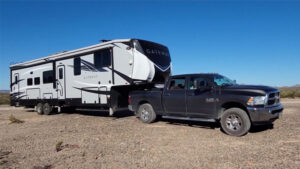 Michelle Brown: We ended up purchasing the Heartland Gateway 3810 RLB. We looked for several years. We went to RV shows, we went to different states, we went to dealers, we looked extensively, researched, and we definitely wanted a bunk room. We have three kids and then with my mom. We always joked that it was her bedroom. But we wanted people to be able to come and enjoy our journey with us, so it was very important that we had a bunk room and a half-bath so that they felt comfortable and they had their own area.
Michelle Brown: We ended up purchasing the Heartland Gateway 3810 RLB. We looked for several years. We went to RV shows, we went to different states, we went to dealers, we looked extensively, researched, and we definitely wanted a bunk room. We have three kids and then with my mom. We always joked that it was her bedroom. But we wanted people to be able to come and enjoy our journey with us, so it was very important that we had a bunk room and a half-bath so that they felt comfortable and they had their own area.
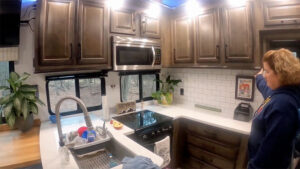 And then another thing that was important to me was the kitchen. I wanted a separate kitchen where I wasn’t looking at the TV through an island. And that was just a preference for me, so this one checked off those boxes.
And then another thing that was important to me was the kitchen. I wanted a separate kitchen where I wasn’t looking at the TV through an island. And that was just a preference for me, so this one checked off those boxes.
Jody: I wanted a residential fridge. And we had good seating in there and just, obviously, we had to figure out the truck size for pulling the weight of it and we wanted a lot of storage ’cause it was our home. When we first started, it’s like, you don’t know what you need to take with you and what you need to put in storage back home.
Michelle: And a washer and dryer was very important to me because I did not wanna have to go to a laundromat all the time. I wanted to be able to throw a load of washing in and dry it,
Michelle Fontaine: I asked Jody to explain the solar system they developed to provide enough wattage to live a comfortable life in their home off grid. There’s lots of detail here and you can see the full unedited version right here.
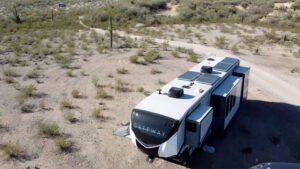 Jody: On the roof we have four threaded 90-watt panels and at 1,560 total watts, 600-amp-hour batteries, and I actually, last year, found an extremely cheap way to run air conditioning. Well, most of your air conditioners on your RVs are 15,000 Btu or 13,500 Btu, which take about 3,500 watts to start, but once they’re running it’s only 1,500 watts. I got a 3,000-watt inverter, which wouldn’t be able to start it, and most people do. There’s very few people with 4,000-watt inverters. So, my engineer friend told me to go to a plumbing supply warehouse and get this can called a hard boost, which is a booster capacitor. It was only $10 and you just hook it to your capacitor and it brings your wattage down to about 2,200 watts to start.
Jody: On the roof we have four threaded 90-watt panels and at 1,560 total watts, 600-amp-hour batteries, and I actually, last year, found an extremely cheap way to run air conditioning. Well, most of your air conditioners on your RVs are 15,000 Btu or 13,500 Btu, which take about 3,500 watts to start, but once they’re running it’s only 1,500 watts. I got a 3,000-watt inverter, which wouldn’t be able to start it, and most people do. There’s very few people with 4,000-watt inverters. So, my engineer friend told me to go to a plumbing supply warehouse and get this can called a hard boost, which is a booster capacitor. It was only $10 and you just hook it to your capacitor and it brings your wattage down to about 2,200 watts to start.
When we were traveling back from Glacier, Montana, across Nebraska in August, we have cats in the back and it was getting too hot in there so we would just drive with our air– one air conditioner on. You can only run one air conditioner at a time. They’re set up to go throughout your whole vehicle. As long as you run it midday or afternoon or whatever, when you have full sun, it won’t even draw on the batteries.
Michelle: So some of the things I’ve done, I’ve just tried to make it feel more like a home. I’ve been able to hang pictures on the wall, glass, framed pictures, and figured out Velcro strips that I can do that with, and they stay up great. I painted the walls. I’m still in the process of doing that, just taking it slowly, a little bit at a time. I put wallpaper in my bedroom. We took out a counter and added a butcher block wood table, pushed it against the wall. Gave us additional storage.
We’ve cut a hole in the wall that gets to this outside storage unit, and we put our kitty litter out there and our cat food.
We took out the jackknife sofa that was in the back that was totally uncomfortable to sleep on, and we built a bed that can pull out and do two twin mattresses if we need it to, to be a king-size bed or, if not, it just pushed in and it’s a twin. And we have storage underneath that.
Michelle Fontaine: With a 40-foot rig, let’s find out how they find accessible spots to dry camp.
Michelle Brown: And I have two boondocking RV groups that I’m a member of, and a lot of people will post areas that they’re in and they’ll give coordinates. If I know we’re gonna be in an area and I see something interesting, I will take a screenshot of it so then I can give it to him and then he can see if it’s something that is accessible for us or the area that we’re gonna be in, and then he takes it from there.
Jody: Yeah, I use Campendium probably 98% of the time. What I really like is that you get a lot of reviews from people. A lot of ’em are recent. Michelle wanted to leave here and go up to Grand Canyon for a few days; well, I checked and the camping spots that we wanted to stay, everybody was talking about how muddy it was and how there was– it was inaccessible and stuff. So we’re gonna have to scrap that and just head mainly for home now.
But I really like Campendium, how it tells a lot about the cell service, which is important to us. It tells you dump stations. And a lot of information people will give you on there is where you can get water, where you can dump your trash.
Michelle: When we are out for two weeks, we’ll go to a campground for a day or two and we always park at the campground, wash out tanks. I start laundry and then we go to where we’re gonna be boondocking ’cause we try to get a campground near
where we’re going to be, our next boondocking spot, and we always scout it out with just his truck. We drive the road. Can we turn around? You definitely have to take extra precautions when you’re as big as we are, because you can’t just turn around at the end of any road. So we have very seldom just blindly go into a spot.
Gloria: The United States has a lot of beautiful country, if we just stop and look at it. Everybody wants to go somewhere exotic but, to me, the United States is beautiful.
Michelle Fontaine: Most BLM land is in the western part of our country. I wondered if Jody agreed.
Jody: There really isn’t, honestly, you start getting into Kansas, Nebraska, and everything east of there, it’s hard to find boondocking. There just isn’t the land that there is out west. Out west, pretty much every state has a lot of public land, BLM land, Bureau of Land Management is what that stands for. BLM land, they have their own website that you can go to and see where you can actually camp, and that was some of our best campgrounds we stayed in, which were sort of half boondocking, half hookups, because they didn’t– some of ’em really didn’t have any hookups at all, and then we’d come across some that, for $5, you could have electric too.
Michelle Brown: Sometimes, our boondocking consists of staying in casino parking lots too. Like, or when we were in Glacier Park, Montana, it’s all reservation land where we stay, so we dry camp in a campground, so we don’t pay for hookups.
So there are many ways to boondock. You might be in a parking lot but that’s what we had to do to see the redwoods in California. We stayed at a casino for three nights.
Jody: And that information is also on Campendium. Not only does it do boondocking, it does non-hookups, some hookups, cost. There’s farms, there’s– where’d we stay at? Blue Heron, which is in Tillamook, Oregon, that was really neat to stay at. Just out in their field, you can stay for free, you know? All kinds of neat places other than public land.
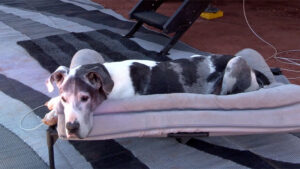 Michelle: We have a ten-and-a-half-year-old Great Dane who travels with us and we have two cats. We always see the vet right before we go out on the road again, get him his checkup. He is on some maintenance medication. We get that at Walgreens. When we leave to go hiking or do whatever we wanna do, is it gonna get too hot in the fifth wheel? And so we were getting concerned about that so we got– it’s called Temp Stick and it’s through WiFi. You do have to have Internet, but I can check the temperature inside the fifth wheel at any point. So then, if it starts to get too hot, and it will alert us. We installed better fans to turn on when we leave to suck out any hot air. And then, I bought him boots to put on his feet so, especially out in the desert, with the cactus and all the rocks. And then, for emergencies– we just had one a couple weeks ago. He cut his leg. We called several local vets. They told us about an emergency hospital and so we went there and they got him taken care of. They are a little bit more expensive, but they were amazing, and, you know, it’s just something that you’ve gotta do. You’ve gotta make sure that they’re okay and well taken care of.
Michelle: We have a ten-and-a-half-year-old Great Dane who travels with us and we have two cats. We always see the vet right before we go out on the road again, get him his checkup. He is on some maintenance medication. We get that at Walgreens. When we leave to go hiking or do whatever we wanna do, is it gonna get too hot in the fifth wheel? And so we were getting concerned about that so we got– it’s called Temp Stick and it’s through WiFi. You do have to have Internet, but I can check the temperature inside the fifth wheel at any point. So then, if it starts to get too hot, and it will alert us. We installed better fans to turn on when we leave to suck out any hot air. And then, I bought him boots to put on his feet so, especially out in the desert, with the cactus and all the rocks. And then, for emergencies– we just had one a couple weeks ago. He cut his leg. We called several local vets. They told us about an emergency hospital and so we went there and they got him taken care of. They are a little bit more expensive, but they were amazing, and, you know, it’s just something that you’ve gotta do. You’ve gotta make sure that they’re okay and well taken care of.
Michelle Fontaine: Well, this has been a true pleasure. Thank you so much for sharing your lives with me today.
